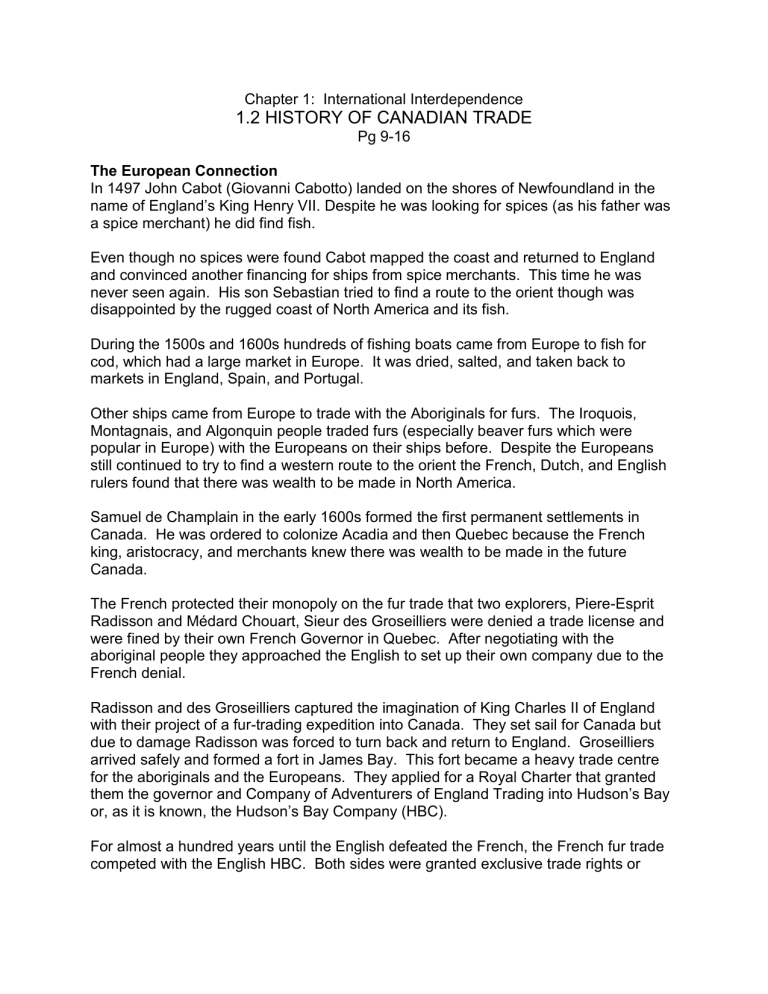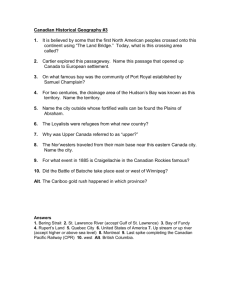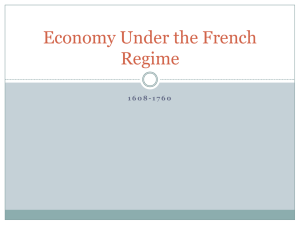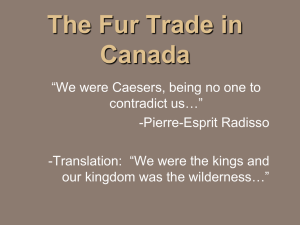1.2 HISTORY OF CANADIAN TRADE

Chapter 1: International Interdependence
1.2 HISTORY OF CANADIAN TRADE
Pg 9-16
The European Connection
In 1497 John Cabot (Giovanni Cabotto) landed on the shores of Newfoundland in the name of England’s King Henry VII. Despite he was looking for spices (as his father was a spice merchant) he did find fish.
Even though no spices were found Cabot mapped the coast and returned to England and convinced another financing for ships from spice merchants. This time he was never seen again. His son Sebastian tried to find a route to the orient though was disappointed by the rugged coast of North America and its fish.
During the 1500s and 1600s hundreds of fishing boats came from Europe to fish for cod, which had a large market in Europe. It was dried, salted, and taken back to markets in England, Spain, and Portugal.
Other ships came from Europe to trade with the Aboriginals for furs. The Iroquois,
Montagnais, and Algonquin people traded furs (especially beaver furs which were popular in Europe) with the Europeans on their ships before. Despite the Europeans still continued to try to find a western route to the orient the French, Dutch, and English rulers found that there was wealth to be made in North America.
Samuel de Champlain in the early 1600s formed the first permanent settlements in
Canada. He was ordered to colonize Acadia and then Quebec because the French king, aristocracy, and merchants knew there was wealth to be made in the future
Canada.
The French protected their monopoly on the fur trade that two explorers, Piere-Esprit
Radisson and Médard Chouart, Sieur des Groseilliers were denied a trade license and were fined by their own French Governor in Quebec. After negotiating with the aboriginal people they approached the English to set up their own company due to the
French denial.
Radisson and des Groseilliers captured the imagination of King Charles II of England with their project of a fur-trading expedition into Canada. They set sail for Canada but due to damage Radisson was forced to turn back and return to England. Groseilliers arrived safely and formed a fort in James Bay. This fort became a heavy trade centre for the aboriginals and the Europeans. They applied for a Royal Charter that granted them the governor and Company of Adventur ers of England Trading into Hudson’s Bay or, as it is known, the Hudson’s Bay Company (HBC).
For almost a hundred years until the English defeated the French, the French fur trade competed with the English HBC. Both sides were granted exclusive trade rights or
Charters by their respective European governments, and both the English and French fought for exclusive control.
Trade had an immediate effect on the Aboriginal populations. Both the Cree and
Assiniboine were the main suppliers of furs. The Cree had an extensive distribution network and hunting network in western Canada. The hunting parties began to generate surplus goods. The animals they trapped were not only for furs, but also food, clothing, and shelter. The self-sufficiency principle was replaced with the principles of trade (generate a surplus, trade the surplus for goods you cannot obtain, sell those goods to others so you can gain their surplus, etc.). This was the beginning of interdependence.
Further settlements were established in support of the fur trade, which in turn caused more immigration. As people arrived their attachment to their homeland stayed through trade. Due to Canada not having a strong manufacturing industry, therefore requiring shipments from Europe to flow back and forth from continent to continent. Their was a dependence for raw materials from Canada for Europe. This set the trade relationship with Europe and solidified the future face of Canada.
The American Connection
USA and Canada were being explored at the same time, Canada by the French and
English, and the U.S. by the English and Dutch. The Dutch work for the West India
Company formed by wealthy Dutch investors in Amsterdam, to take advantage of the trade opportunities in the Caribbean and to break the Spanish trade monopoly. They also setup a trade post on what is now New York.
By 1720, American trade looked very different from Canadian trade in the Canadian traders focused on the European connection, while the US developed a much more diversified network of trading partners stretching well into South America.
Sugar was important in the history of American trade, American farmers provided the
Caribbean markets with food. Ships loaded left the port of New York in between
November and January. The ships returned full of sugar between April and June.
The brown sugar processed in New York was refined into white table sugar, which was made into candy or bagged for sale. The residue molasses was distilled into rum which was traded in Europe and the West India, This trade was very profitable for thousands of American businesses involved. The US not only exported raw materials like cotton, but also processed goods like cotton yarn, fabric, and manufactured cotton clothing.
Canada's trade was still dominated by raw materials sent to England. The American
Revolution and the War of 1812 put strain on the relationship between Canada and the
US, however despite political problems, many Canadian businesses were looking south to the US for a trading partner, instead of east towards Britain.
Canada was still dependent on the fur trade during this time. In 1779 a group of 16 merchants consortium, called North West Company. It was Canadian owned and fierce
competition for the British owned Hudson's Bay company. North West Company was also competition for America companies. This caused the US to pass a law in 1816 making it illegal for Canadians to trade furs in the US. It effectively forced the two major
Canadian fur trading companiess to join forces, the competition was hurting both company's. They merged under the name of Hudson's Bay Company. The result was a fur trading company that was the most powerful on the continent.
By 1840's, silk had replaced beaver as the material of choice for hats is Europe. In
Canada over-trapping had depleted the beaver stocks. The fur trade in Canada never regain its significance.
As trade increased between Canada and the US, some Canadians feared a political alliance with the US. The major economic and industrial centers on both countries were located on the Eastern seaboard and in the central regions. Canada become a nation in
1867, partially as a response as international trade goods and also as a response to the fear of unification with, or even domination by, the US.
A group of Canadian and British businesses men began to argue for a railway across
Canada east to west cost. The Canadian Pacific Railway was completed in 1885, which brought B.C. Into the confederation.
Confederation and the CPR did not stop the growth of commerce between the two countries. The US would become Canada's biggest trading partner, even to this day.
The Pacific Rim Connection
Japan led the way with a policy of modernization after the Second World War. In 1945
Japans industries were pretty well destroyed but with North American aid, factories were rebuilt to high standards, providing modern manufacturing facilities.
Japan entered the North American market in the 1950’s with inexpensive toys, novelties, and electronic equipment. The phrase “Made in Japan” was synonymous with
“cheap”.
For decades Japan has managed to become some of the most popular brands in the world. Japan has led the other Pacific countries into international trade and is now a major trading partner with Canada.
Mexico and the Americas
In 1993, Canada signed the North American Free Trade Agreement (NAFTA)
And began to eliminate all trade barriers among the United States, Mexico, and Canada by the year 2008. NAFTA was an initiative spearheaded by the United States,and although the United States has a much stronger trading relationship with Mexico already in place, Canada is benefiting as well. The large Mexican consumer market provides new opportunities for the sale of Canadian products, and Canadian branch
plants can take advantage of lower Mexican labor costs to manufacture goods for shipment to the southern United States. Prior to the agreement, Canada did very little trade in
Central and South America.
Trade between Mexico and Canada increased significantly after the agreement was signed
. NAFTA’s success caught the attention of other Central and South American countries. An effort to unite the economies of the Americas into a single free trade arrangement was initiated at the Summit of the Americas, held in December 1994 in
Miami, Florida. The heads of state of the 34 democracies in the region agreed to construct a Free Trade Area of the Americas (FTAA) and to complete negotiations for the agreement by 2005. Canada has taken a leadership role in these negotiations, partly because of a successful bilateral trade agreement negotiated with Chile and partly because political differences between the American Democrats and Republicans make it difficult for the United States to assume the role.
It is difficult to predict the future of Canada’s trade with Central and South America. Our largest trade partners are still, in order, the United States, Japan, and the United
Kingdom. But trade shifts in unpredictable ways, as shown by Japan’s post-Second
World War emergence as a major trading power. At the very least, the proposed FTAA will offer Canadian businesses interesting opportunities.




